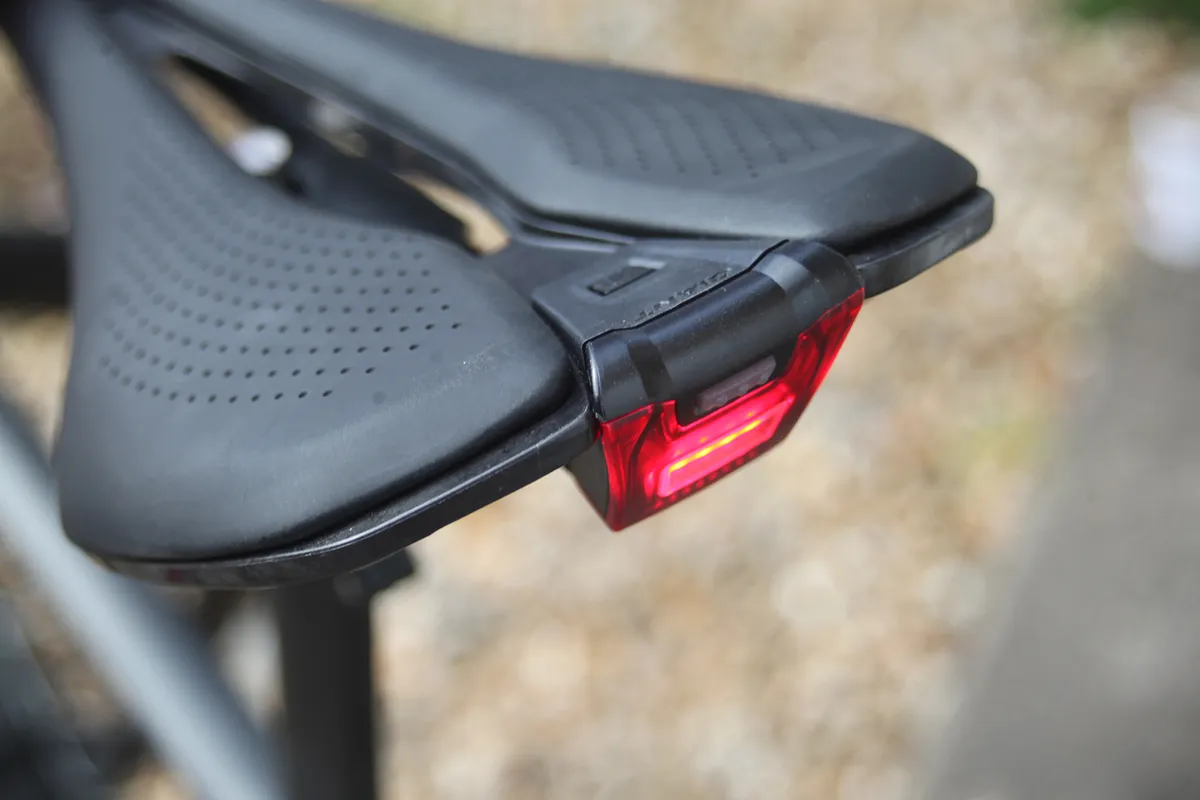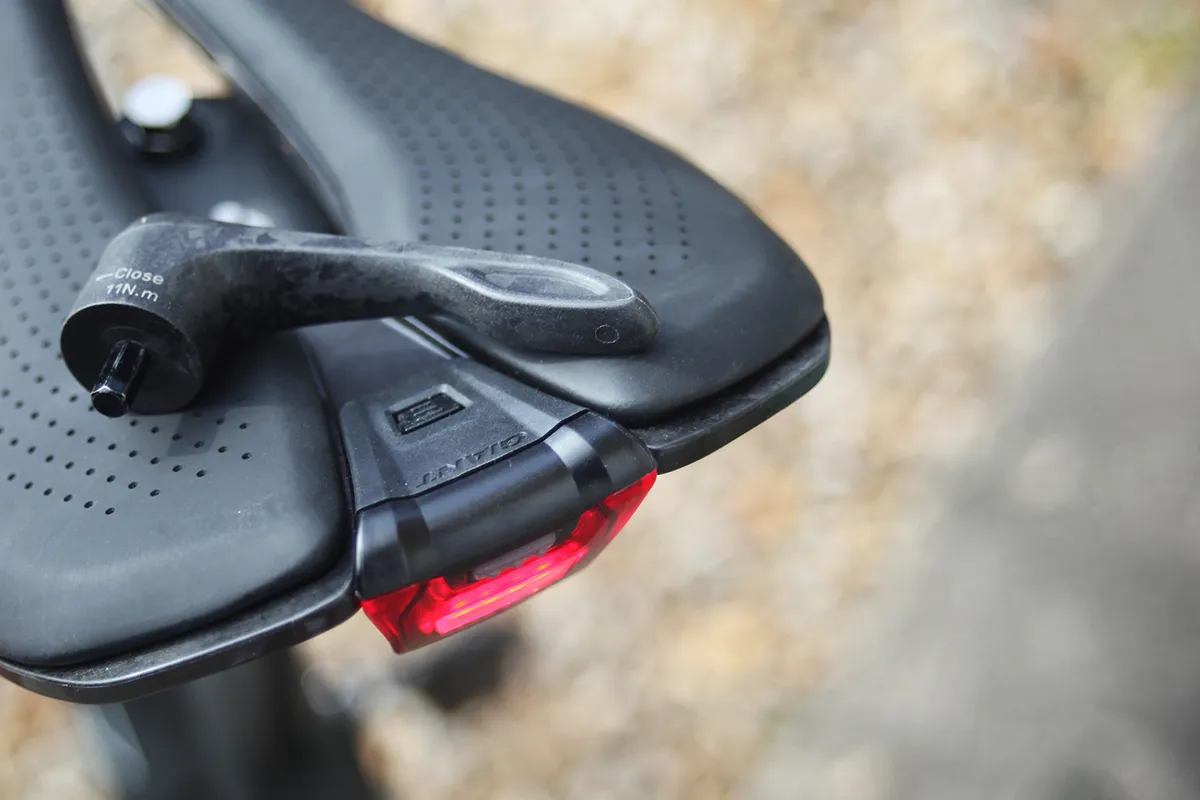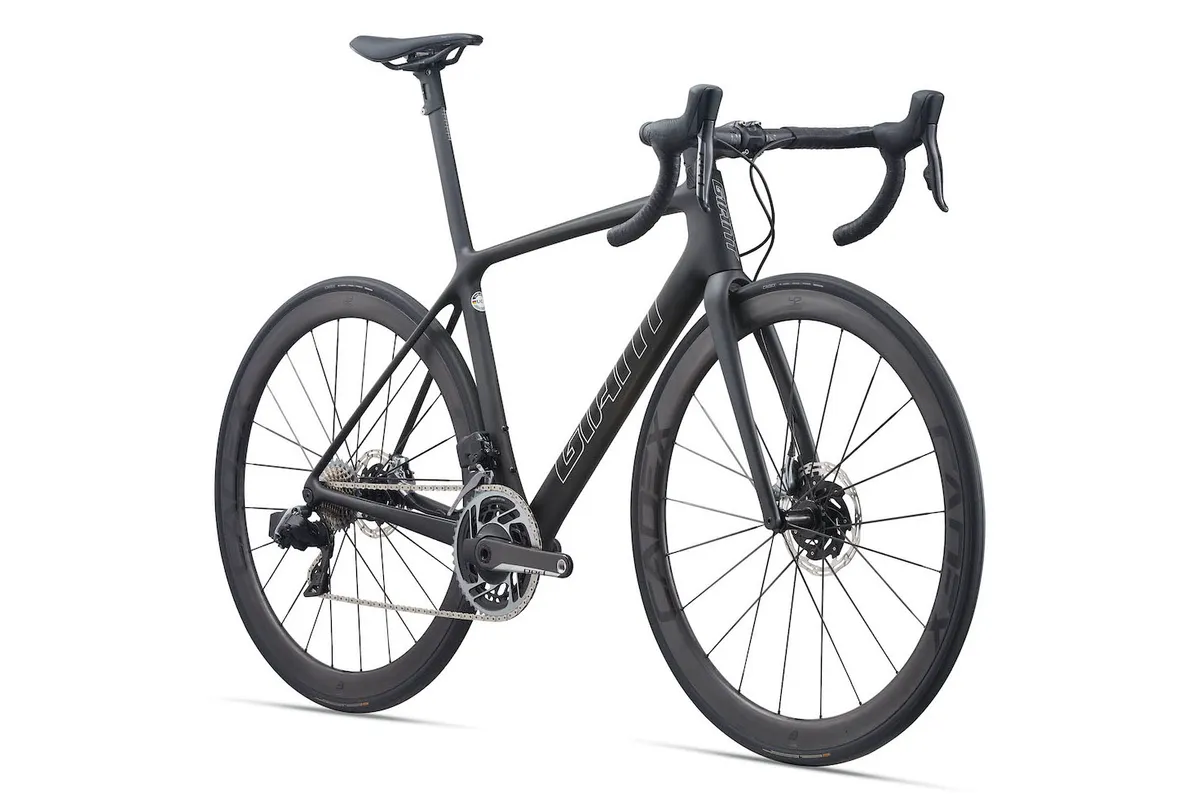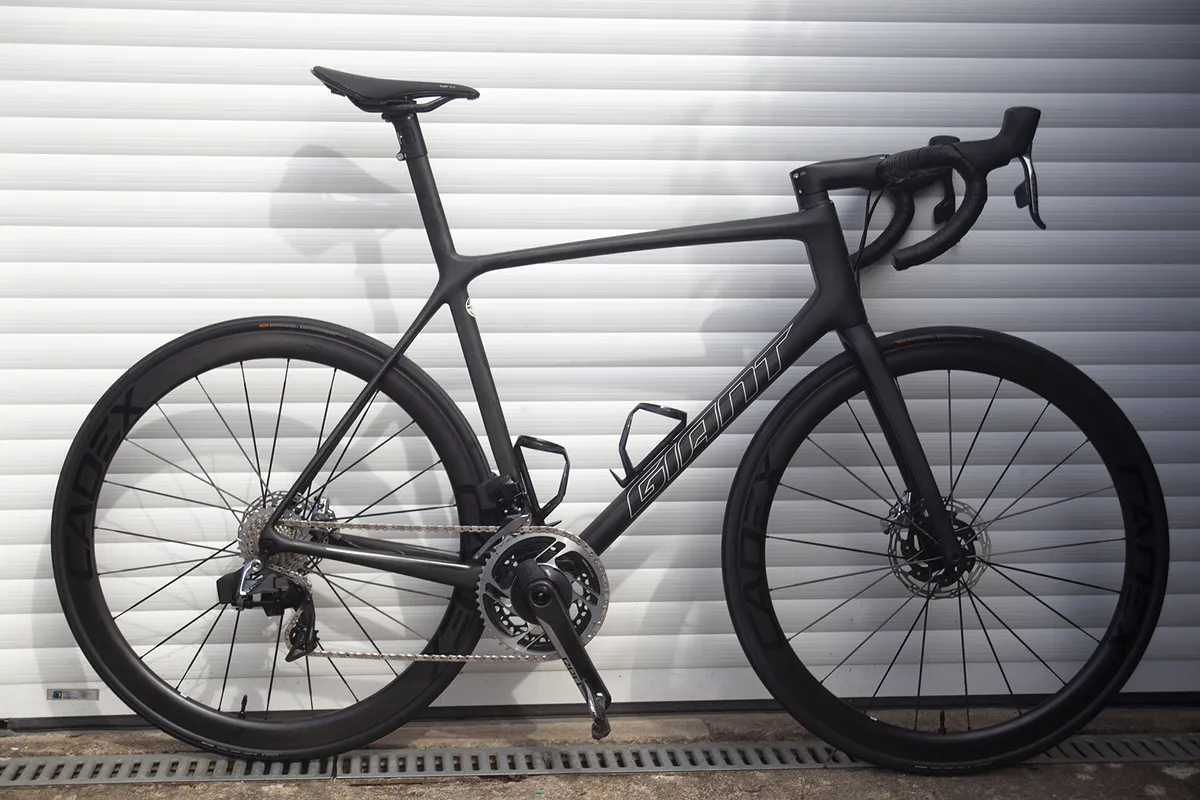Giant has launched the ninth-generation TCR, with the 2021 flagship TCR Advanced SL Disc frame said to be lighter, stiffer and more aerodynamic than the outgoing model.
We spotted Greg Van Avermaet and other Team CCC riders riding the new TCR at the back-end of 2019 and now Giant is ready to officially launch the latest version of a frame that originally helped set the benchmark for modern race bikes.
The 2021 TCR Advanced SL Disc frame comes with a headline claimed weight of 765g. Stiffness-to-weight ratio has also been improved, according to Giant, while a smattering of aero touches have made the new frame faster in the wind tunnel.
Giant's press material for the new TCR contains comparisons with three leading rivals – the Specialized S-Works Tarmac Disc, Trek Emonda SLR Disc and Cervélo R5 Disc – for weight, stiffness-to-weight and aerodynamics. That's the blend of attributes these all-round race bikes are now looking to achieve.
The TCR Advanced SL Disc is said to out-perform all three rivals on most counts (the Emonda is lighter), though this is based on Giant's own testing and, of course, against a very select number of bikes. The aerodynamic difference between the TCR and the Tarmac and R5 is also extremely small.
Giant has also updated the second-tier Advanced Pro Disc and third-tier Advanced Disc frames. Rim brake models are available at all three frame levels.
Read on for everything you need to know about the new Giant TCR, as well as an overview of the 2021 range (click here to jump straight to that section). Otherwise, you can read our full comparison between the 2020 and 2021 TCRs.
2021 Giant TCR | Eight things you need to know
- 765g claimed weight for TCR Advanced SL Disc frame
- Best-in-class stiffness-to-weight ratio, according to Giant
- 'Truncated ellipse' tube profiles to improve aerodynamics
- 34 seconds faster than previous bike over a distance of 40km at 200 watts
- Tyre clearance increased to 32mm on disc frames (28mm for rim brake frames)
- Advanced Pro Disc and Advanced Disc frames also updated
- Rim brake frames available at all three levels
- TCR Advanced SL Disc only compatible with electronic groupsets
Why a new Giant TCR matters
The TCR has been a staple in Giant’s range since 1998, with the first iteration coming from the mind of British bike design legend Mike Burrows (of Chris Boardman’s Lotus pursuit bike fame) back in 1995.
The original took the idea of compact sloping frame geometry from mountain biking and adapted it for the road (TCR stands for Total Compact Road). The idea was that a smaller front triangle was both lighter and stiffer than a traditional frame with a horizontal, non-sloping top tube.
The back end was also more ‘compact’, which saved weight and made the engineers' job easier by improving power transfer and efficiency.
The early models also had a significant advantage when it came to aerodynamics, thanks to a longer seatpost that could be aero-shaped and built from carbon fibre to also aid comfort.
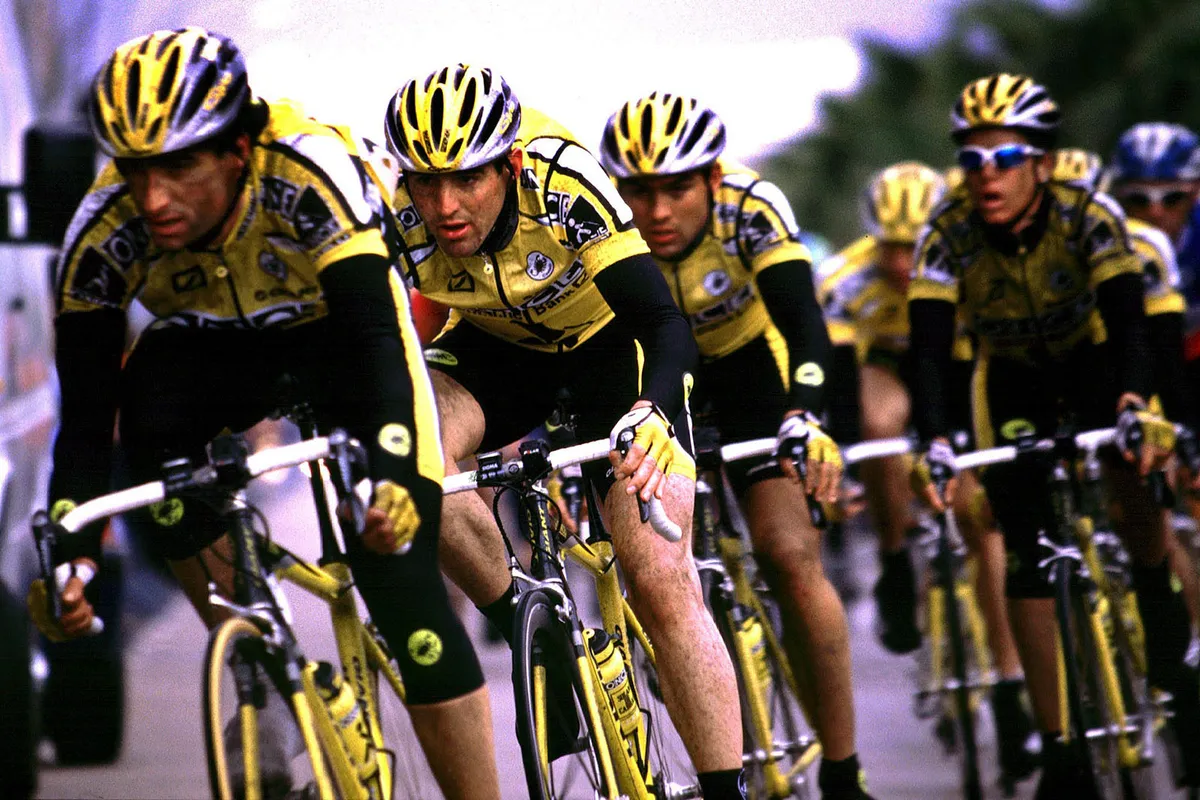
The early design had a few run-ins with officialdom, seeing Giant even appealing a decision by the UCI in court. Eventually (by late 1997), the bike was deemed legal and was ridden in earnest from 1998, with legends such as Laurent Jalabert of the ONCE team taking plenty of major victories on board the TCR.
It’s easy to underestimate just how influential the TCR has been. Look at today’s peloton and it's hard to find any bike that doesn’t subscribe to the compact mantra. However, in recent years, most of Giant’s competitors have launched new lightweight compact bikes with a nod to aerodynamics blended in.
Now, having last been overhauled in 2016, Giant has decided it's time for the venerable TCR to be revised, too. That’s not an easy task when you consider the 2020 TCR Advanced SL Disc has a flyweight 818g frame, which is still a match for pretty much every other pro-level disc frame on the market.
It's lighter…
In the process of developing the new TCR, Giant has refined its ‘advanced’ manufacturing processes to achieve a 765g claimed weight for the flagship 2021 TCR Advanced SL Disc frame.
For the latest TCR, Giant has taken raw carbon fibre and weaved the materials to its exact specification (in its own composites factory) to create the lightest set of raw pieces ever put together for a Giant bike.
Combined with this is a new carbon nanotube-infused resin – a microscopic polymer that acts like miniature buttresses to strengthen the layers of carbon composite and significantly improve impact resistance, according to Giant.
The bonding material is infused with nano-sized particles of carbon fibre, said to eliminate any structural voids in the whole of the frame structure.
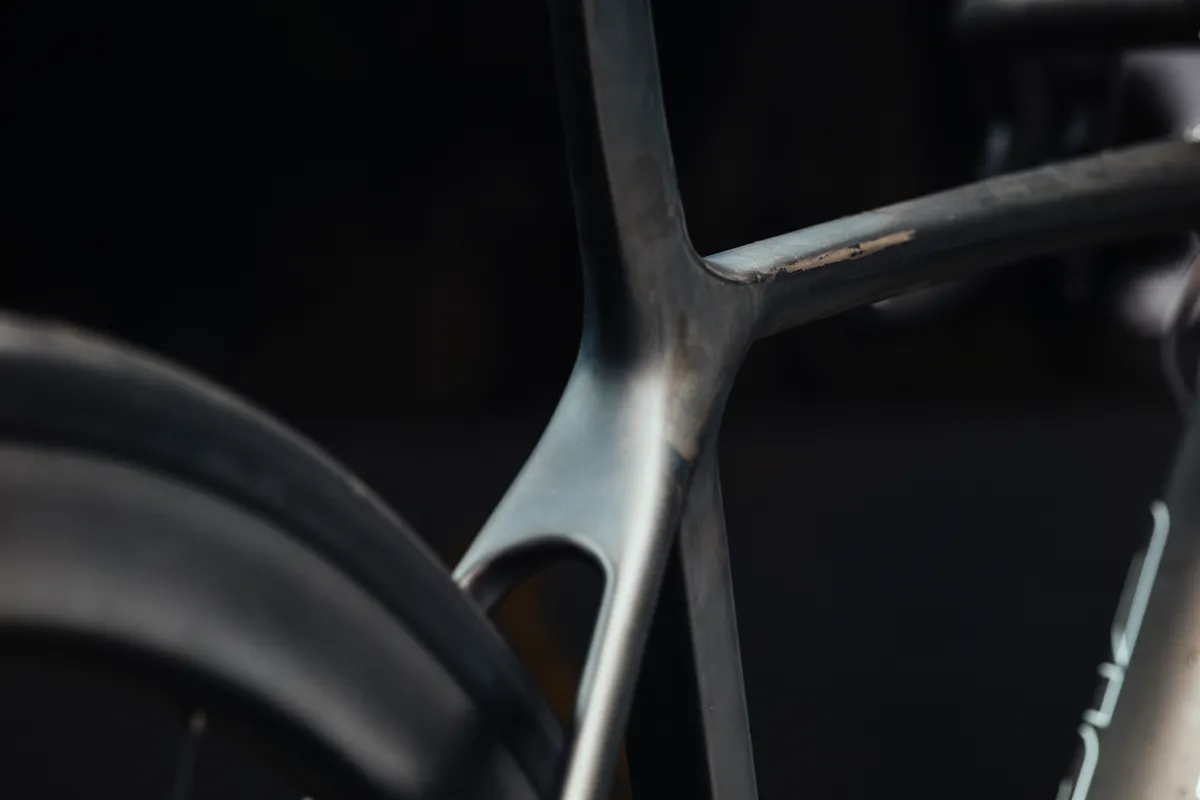
The outer skin of the Advanced SL 0 model is also treated to a whole new process, using 'ThinLine' paint. This is claimed to save 65g over Giant’s standard seven-layer paint application on a medium frame.
A proprietary 3M adhesive protector has also been added to the clamping section of the integrated seatpost, in a bid to help with weight saving without sacrificing strength and security due of the ‘thinness’ of the paint process.
Meanwhile, the top tube is attached to the seat tube using a grafting process that combines filament winding and co-moulding. This involves hand-weaving the top tube and seat tube together and then re-moulding the area under heat and pressure, which Giant claims creates a much stronger, yet lighter junction than traditional carbon moulding processes.
Elsewhere, Giant has reduced the number of pieces that make up the frame, using continuous fibres through the down tube, head tube and seat tube. There are more than 500 pieces of woven carbon used throughout the frameset, compared to the 2020 model's 380.
Every piece on the new chassis is laser cut rather than the traditional machine-stamped process, and Giant has automated the layup on some of the frame's critical areas, using robotics on 150 of the smallest pieces of carbon. This, according to Giant, ensures consistent and accurate manufacturing.
The remaining 350+ pieces are hand-laid into the frame.
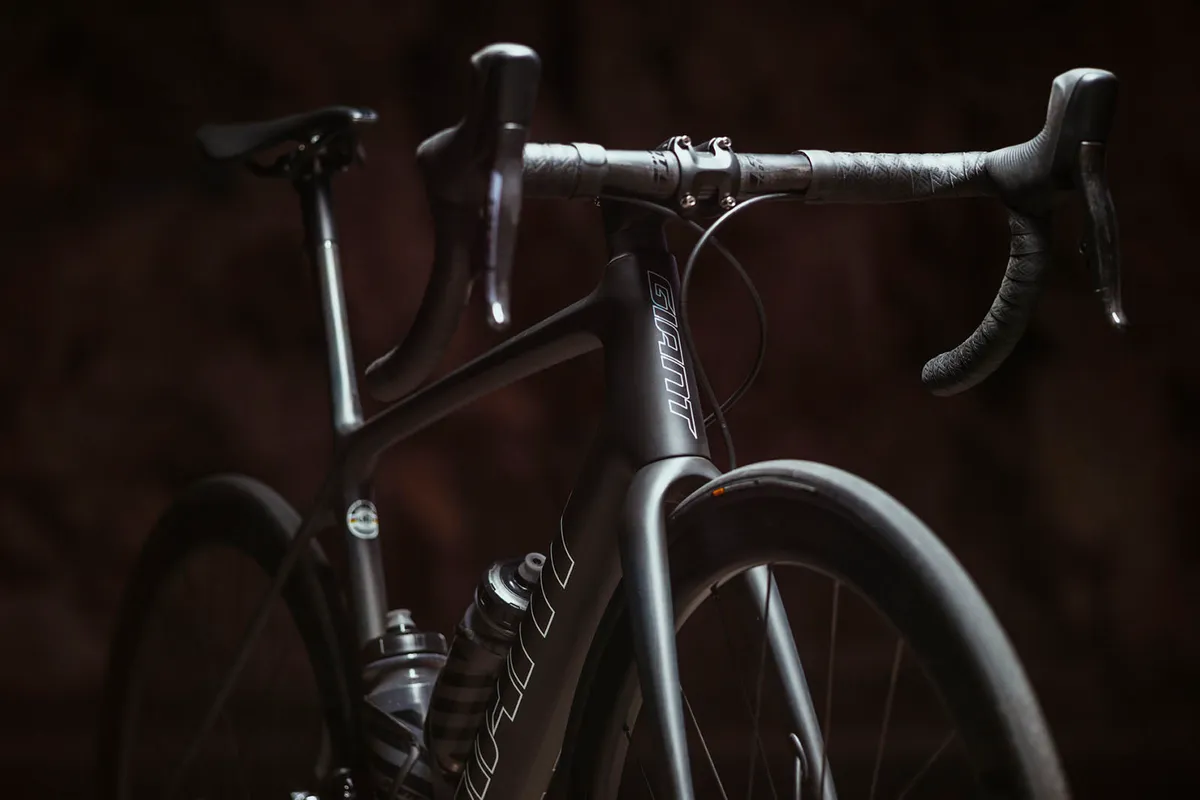
Weight has been eked out elsewhere, with the ISP seat clamp gaining forged composite clamps, while the new two-piece rear mech hanger is said to be both lighter and stiffer.
In fact, Giant says the only carry over from the 2020 model in the whole chassis is a couple of rubber bungs and the headset bearings.
Weight wise, the new frameset – which Giant defines as a medium frame fully finished with headset, expander and top cap fitted, seatpost (ISP), seat clamp or ISP clamp, derailleur hanger/clamp, and all production hardware (bottle cage bolts etc) – is claimed to be 140.43g lighter than the outgoing TCR.
That's a pretty impressive saving on what was already a very lightweight frame.
Weight comparison between 2020 and 2021 TCR Advanced SL Disc
| Weight (g) | 2020 | 2021 | Diff (g) |
|---|---|---|---|
| Frame | 818 | 765 | -53 |
| Fork | 331 | 330 | -1 |
| Cone | 7.19 | 3.64 | -3.55 |
| Spacer | 14.37 | 19.59 | 5.22 |
| Top cap | 15.6 | 6.6 | -9 |
| ISP clamp | 118 | 103.9 | -14.1 |
| Frame paint | 100 | 50 | -50 |
| Fork paint | 25 | 10 | -15 |
| Total weight saving | -140.43 |
Comparative weights between 2021 TCR and rival framesets
Giant says all rival framesets were purchased at retail for testing.
| Weight (g) | Giant TCR Advanced SL Disc | Specialized S-Works Tarmac Disc | Trek Emonda SLR Disc | Cervélo R5 Disc |
|---|---|---|---|---|
| Frameset (complete and painted) | 1,266 | 1,371 | 1,249 | 1,588 |
| Total saving | 105 | -17 | 322 |
It's stiffer…
Making a lighter chassis is one thing, but it must work in conjunction with the overall performance of the bike. To this end, Giant has worked on maximising the stiffness-to-weight ratio throughout the frame.
More frame stiffness means better cornering and a responsive ride out on the road, according to Giant. Also, improved stiffness through the drivetrain results in improved power transmission – in short, more speed for less effort.
Giant says the new TCR offers a best-in-class stiffness-to-weight ratio. The new frame was tested in the lab alongside the Specialized S-Works Tarmac Disc, Trek Emonda SLR Disc and Cervélo R5 Disc.
Stiffness-to weight comparison between 2021 TCR and rival framesets
Stiffness was tested by locking the rear dropouts down and then applying lateral force onto the fork, according to Giant.
| Giant TCR Advanced SL Disc | Specialized S-Works Tarmac Disc | Trek Emonda SLR Disc | Cervélo R5 Disc | |
|---|---|---|---|---|
| Transmission stiffness (lateral fork and frame pedalling) | 149.8 (N/mm) | 135 (N/mm) | 110.4 (N/mm) | 124.9 (N/mm) |
| Frameset weight (complete and painted) | 1.27 kg | 1.37 kg | 1.25 kg | 1.59 kg |
| Stiffness to weight ratio | 118 | 98 (-16% less efficient) | 88.3 (-25% less efficient) | 79 (-33% less efficient) |
It's more aerodynamic…
Low weight and impressive stiffness have been hallmarks of the TCR for some time. This 2021 model brings aerodynamics to the party, though it's an evolution rather than aero revolution.
Like most of the TCR’s rivals, the new bike was developed with low weight, stiffness and aerodynamics working alongside one another – it's an all-rounder, rather than a fully-fledged aero bike.
The shape, though still very familiar, has been honed by computational fluid dynamics (CFD) and wind tunnel testing alongside real world riding – prototypes of the new TCR competed in events throughout 2019.

The new frame uses tubing that Giant is calling 'truncated ellipse’; a step on from the Kammtail-like shapes we’ve seen from Trek and many others.
Giant claims this new, more rounded take on the truncated airfoil attains lower drag numbers across a wider range of yaw angles (the direction at which the wind hits the bike).
In reality, this means the new down tube is much broader than the previous model because it was designed around having standard 22oz (624g) water bottles in place.
Giant also concentrated on making the TCR more of a 'system', though it hasn’t resorted to the high levels of integration we’ve seen on other aero-road bike designs, including Giant's own Propel.
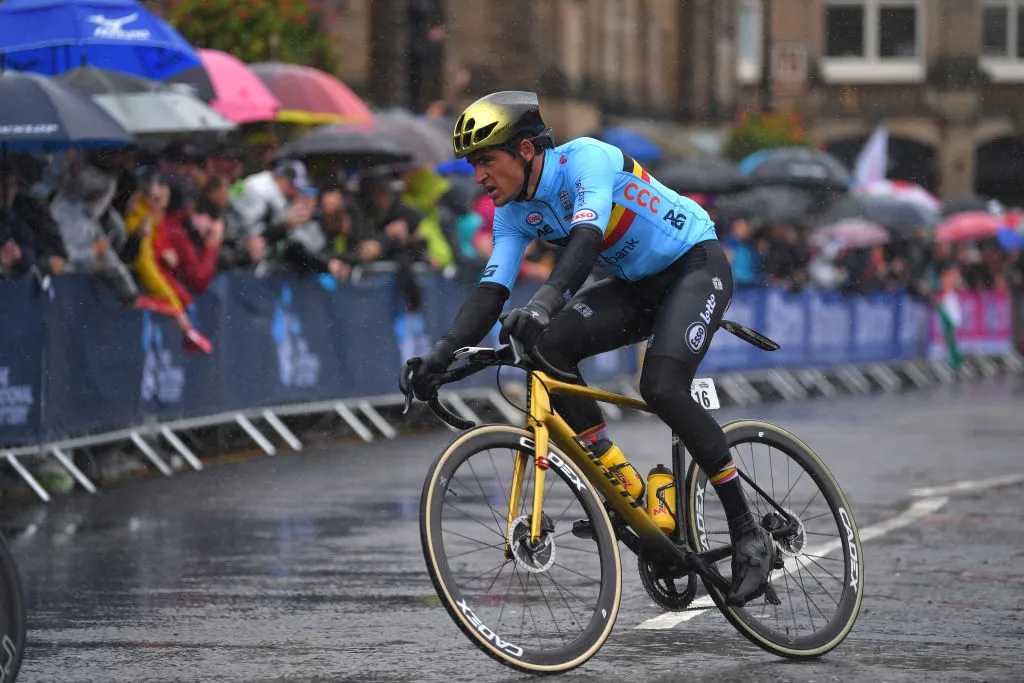
That means Giant's wind tunnel research, based out of Immenstaad in Germany, included frame, fork, cockpit and the new Cadex wheelset, and how they work in conjunction with each other.
The TCR Disc’s new fork is wider, to accommodate up to 32mm tyres (clearance is limited to 28mm on rim brakes frames), and is also symmetric, unlike the previous generation's disc fork. Giant has also routed the hose through the fork for the first time and worked on the hose exit in relation to the brake unit and fork leg.
The new carbon stem uses a traditional clamp and integrates a GPS mount into its two lower stem bolts.
The new Contact SLR carbon bar has also had an aero makeover without going overtly wing-shaped – it's closer to the Defy's handlebar (our Endurance Road Bike of the Year for 2020) – and the cable and hose routing is guided by aerodynamics while still being user friendly. This isn't a fully integrated, cable-free aero cockpit.
Wind tunnel test data
Giant's wind tunnel testing included a mannequin, spinning wheels and bikes holding two bottles and cages each. Testing took place across yaw angles ranging from -15 to +15 degrees, with the Specialized S-Works Tarmac Disc, Trek Emonda SLR Disc and Cervélo R5 Disc also tested.
According to Giant, the TCR Advanced SL produced the least amount of drag on average, though as you can see from the table below, the differences are very, very small in the case of the TCR, Tarmac and R5.
The new TCR is, however, said to be significantly more aerodynamic than the previous generation bike, saving 34 seconds over a distance of 40km at 200 watts, according to Giant.
| Giant TCR Advanced SL Disc | Specialized S-Works Tarmac Disc | Trek Emonda SLR Disc | Cervélo R5 Disc | |
|---|---|---|---|---|
| Average drag @ 40kph with bottles/cages from -15 to +15 degree yaw angles (watts) | 247.5 | 248 | 261.4 | 247.9 |
| Difference (watts) | -0.5 (less aerodynamic) | -13.9 (less aerodynamic) | -0.4 (less aerodynamic) |
The finer details
Aside from the redesigned and now symmetrical fork, and the new tube shapes, the 2021 TCR still looks very familiar, and some of the details of the previous TCR have been retained, albeit lightened and apparently improved.
First up is the ISP (integrated seatpost) with its new ‘Variant’ shaping. It's still designed to offer the aero benefits that hark back to the first TCRs of 1998, but uses a new carbon construction method and refined shaping – claimed to offer improved compliance as well as aerodynamics.
The head tube retains the 'Overdrive 2' design, which combines a 1.5in lower bearing and a 1-1/4in upper bearing. This works in conjunction with a tapered fork steerer, which Giant claims offers class-leading steering stiffness.
'Megadrive' is the name given to the TCR’s massive rectangular-shaped down tube and this holds the key to the core stiffness at the heart of the TCR, linking the 'Overdrive 2' head tube with the PowerCore bottom bracket (BB).
The 86mm-wide PowerCore BB leads into symmetric chainstays that Giant claims provide additional stiffness on the driveside and stability to the non-driveside.
Finally, the flagship TCR Advanced SL Disc is only compatible with electronic groupsets. The more affordable Advanced Pro Disc and Advanced Disc frames will accept electronic or mechanical drivetrains, as will rim brake frames across all three levels.
TCR Advanced Pro Disc and TCR Advanced Disc frames
Aside from the range-topping Advanced SL Disc machine shown here for the launch, Giant also has a second-tier Advanced Pro Disc range and a standard Advanced Disc range.
Also, in a quite surprising move for a 2021 range, there are rim brake models for each level, so there’s something for the die-hard caliper fan to celebrate, too.
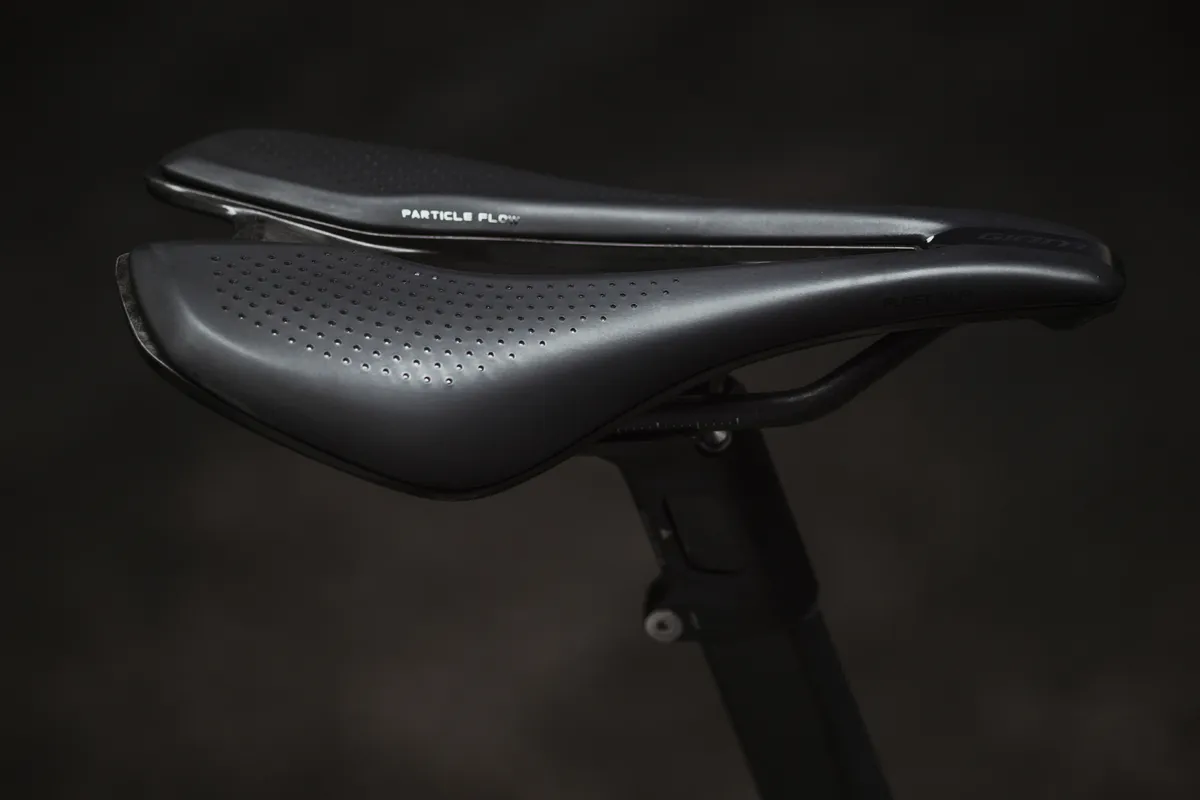
Some riders will worry about using an integrated seatpost, with the need to cut to size, so Giant has addressed this by including two clamps with every SL frameset and bike.
The standard offers 25mm of vertical adjustment and -5/+15mm offset, while the longer clamp offers 45mm of vertical adjustment and -5/+25mm offset.
The more affordable Pro and Advanced bikes use a standard, although still aero-shaped, seatpost. This creates a slight difference in the silhouette between the SL and the rest of the range because the seat tube is deeper on the non-SL bikes to incorporate a traditional post.
It also means the seat tube on non-SL bikes gains a cutaway that shapes around the rear wheel.
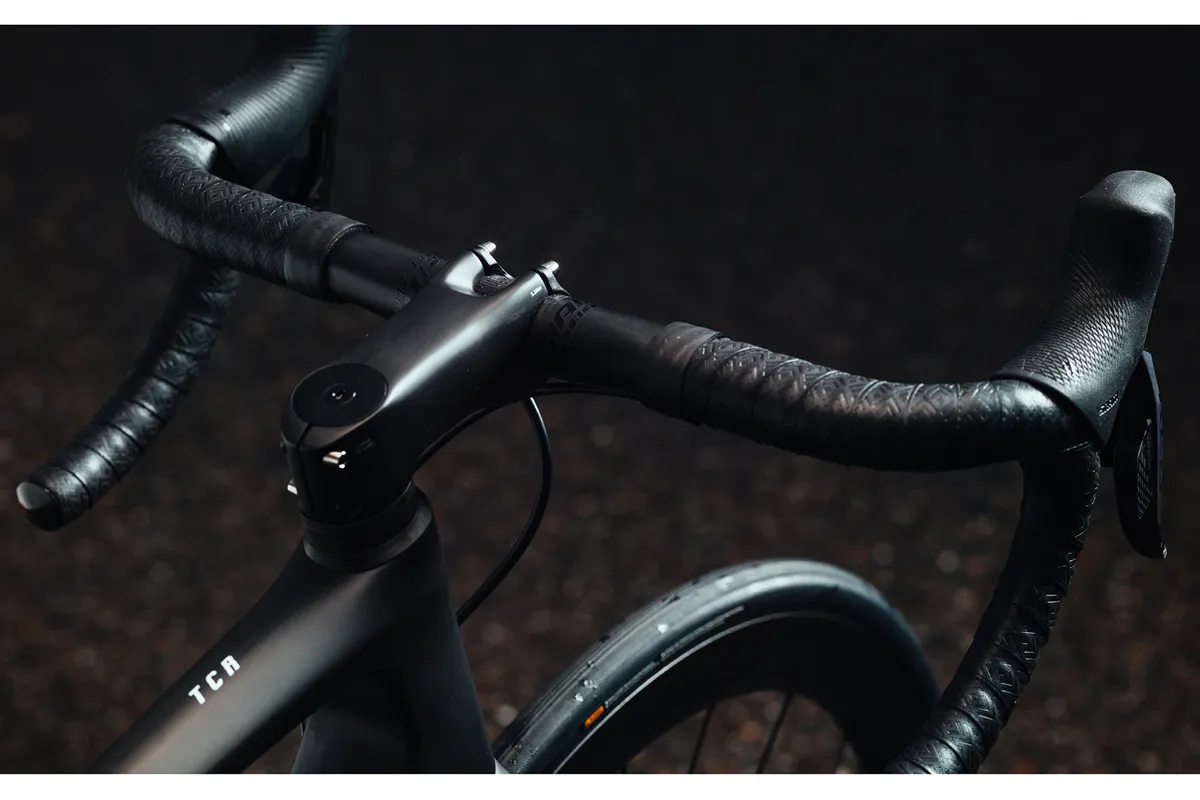
The Pro and Advanced models both share the same frame (though with a different fork), constructed using 100 per cent Toray T700 fibres.
The new Advanced Pro 1 chassis loses 131.6g (medium) over the current model, with 72g of the weight saving coming from the frame and fork.
Meanwhile, the Advanced Disc drops 213.6g (medium) thanks to the switchover to a full carbon fork over the outgoing model.
All of Giant’s wheels gain a new profile based around the 19mm-wide Cadex design, so Giant’s popular SLR-1 carbon wheels (found on Advanced Pro models) are now 129g lighter on the disc model and 62g lighter for the rim brake wheels.
The SLR wheels also switchover to the same internals as used on Cadex wheels, which Giant claims offer 69 per cent less bearing drag on the freehub than the benchmark DT Swiss 240 internals. Even the base model PR-1 alloy wheels get Giant’s new 19mm internal rim profiling and lose weight.
Giant TCR 2021 range overview
Pricing across most markets is still to be confirmed.
Giant tells us it is ready to launch the bike in the Taiwanese and Japanese markets, where the current coronavirus pandemic is under more control and life is returning to close to normality. Pricing and availability for the global market is expected to be confirmed in early May.
TCR Advanced SL 0 Disc
- Frame: Advanced SL-Grade Composite, integrated seatpost, disc
- Fork: Advanced SL-Grade Composite, full-composite OverDrive 2 steerer, disc
- Bar: New Giant Contact SLR
- Stem: New Giant Contact SLR
- Seatpost: Integrated design, two clamps 25mm/45mm
- Saddle: New Giant Fleet SLR
- Gears: SRAM RED eTap AXS 48/35, 10-28 with Quarq DZero power meter
- Brakes: SRAM RED eTap AXS hydraulic, 160mm/140mm rotors
- Wheels: Cadex 42mm Disc WheelSystem
- Extras: Tubeless sealant, out-front mount (Garmin, Wahoo, Giant compatible)
- Price: £TBC / $11,000 / AU$TBC / €TBC
TCR Advanced SL 1 Disc
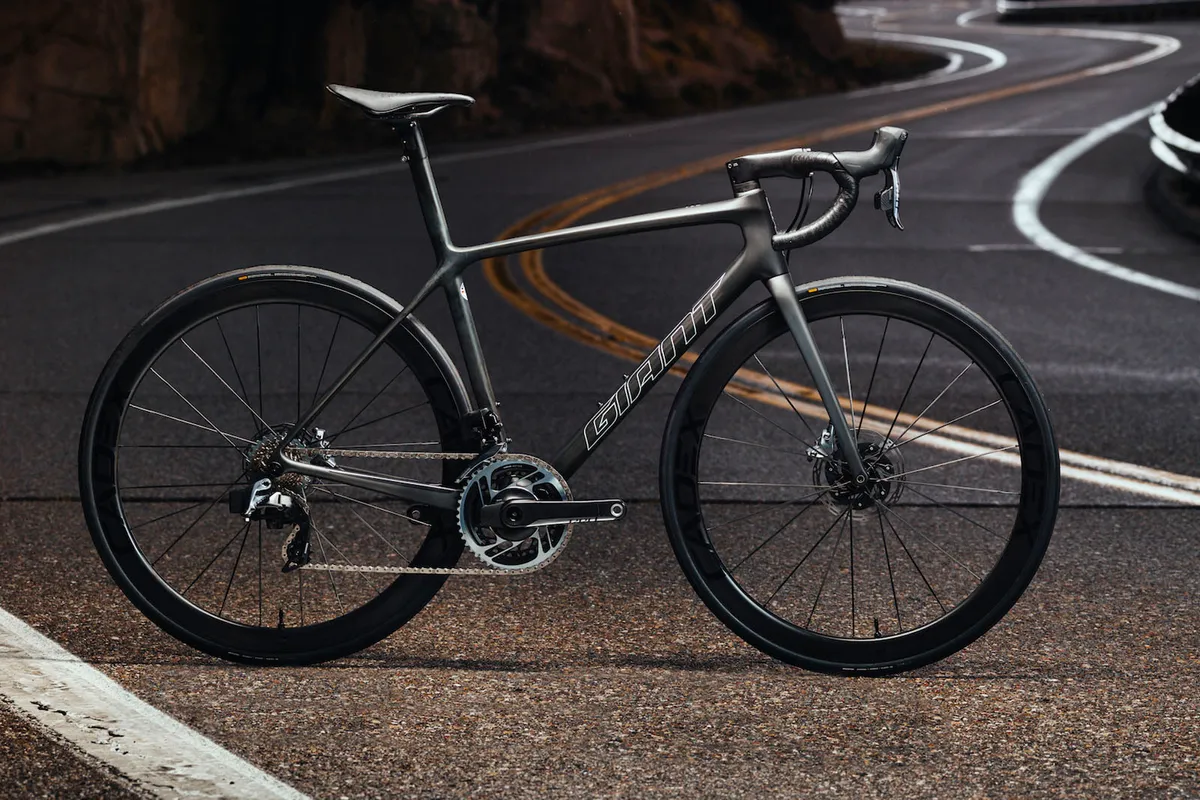
- Frame: Advanced SL-Grade Composite, integrated seatpost, disc
- Fork: Advanced SL-Grade Composite, full-composite OverDrive 2 steerer, disc
- Bar: New Giant Contact SLR
- Stem: New Giant Contact SLR
- Seatpost: Integrated design, two clamps 25mm/45mm
- Saddle: New Giant Fleet SLR
- Gears: SRAM Force eTap AXS 48/35, 10-28 with Quarq DZero power meter
- Brakes: SRAM Force eTap AXS hydraulic, 160mm/140mm rotors
- Wheels: Cadex 42mm Disc WheelSystem
- Extras: Tubeless sealant, out-front mount (Garmin, Wahoo, Giant compatible)
- Price: £TBC / $TBC / AU$TBC / €TBC
TCR Advanced Pro 0 Disc
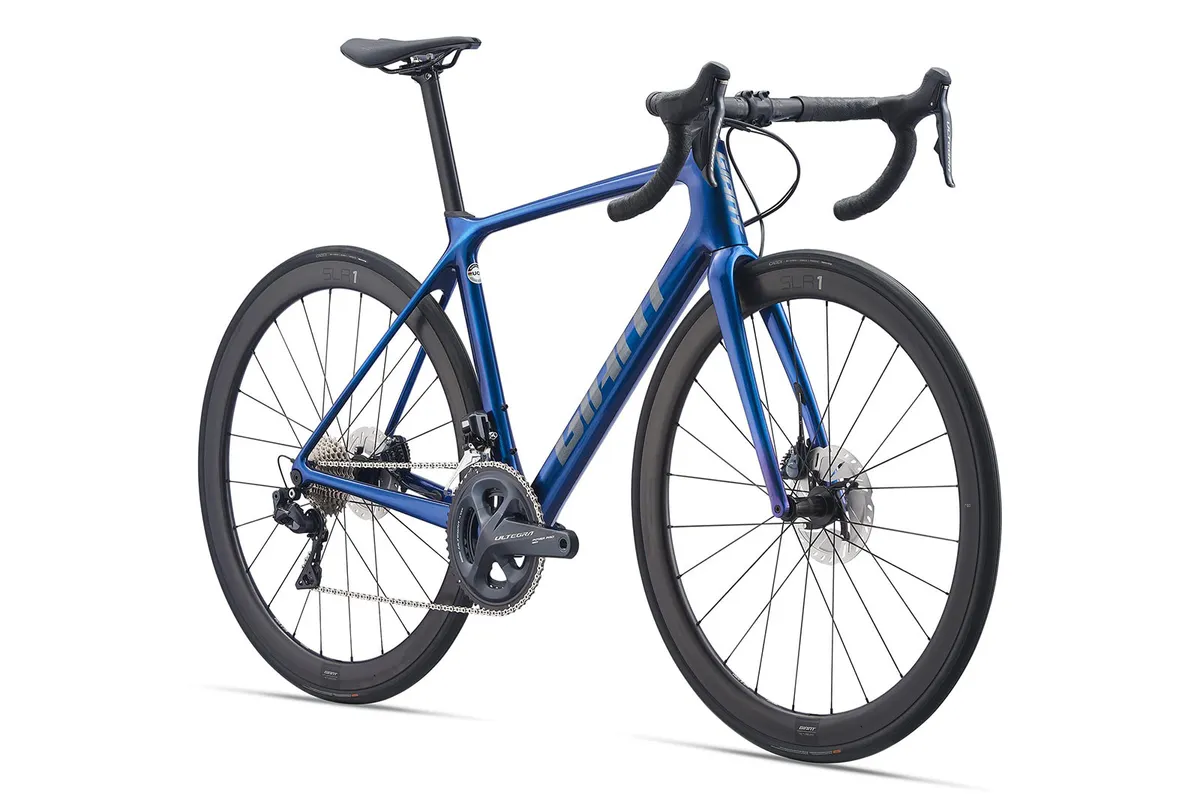
- Frame: Advanced-Grade Composite, disc
- Fork: Advanced-Grade Composite, full-composite OverDrive 2 steerer, disc
- Bar: New Giant Contact SL
- Stem: New Giant Contact SL
- Seatpost: New Giant Variant, composite
- Saddle: New Giant Fleet SL
- Gears: Shimano Ultegra Di2 52/36, 11-30 with Giant PowerPro power meter
- Brakes: Shimano Ultegra hydraulic, 160mm/140mm rotors
- Wheels: New Giant SLR-1 42 Carbon Disc WheelSystem
- Tyres: Cadex Road Race, tubeless, 700 x 25mm, folding
- Extras: Tubeless sealant, out-front mount (Garmin, Wahoo, Giant compatible)
- Price: £TBC / $TBC / AU$TBC / €TBC
TCR Advanced Pro 1 Disc
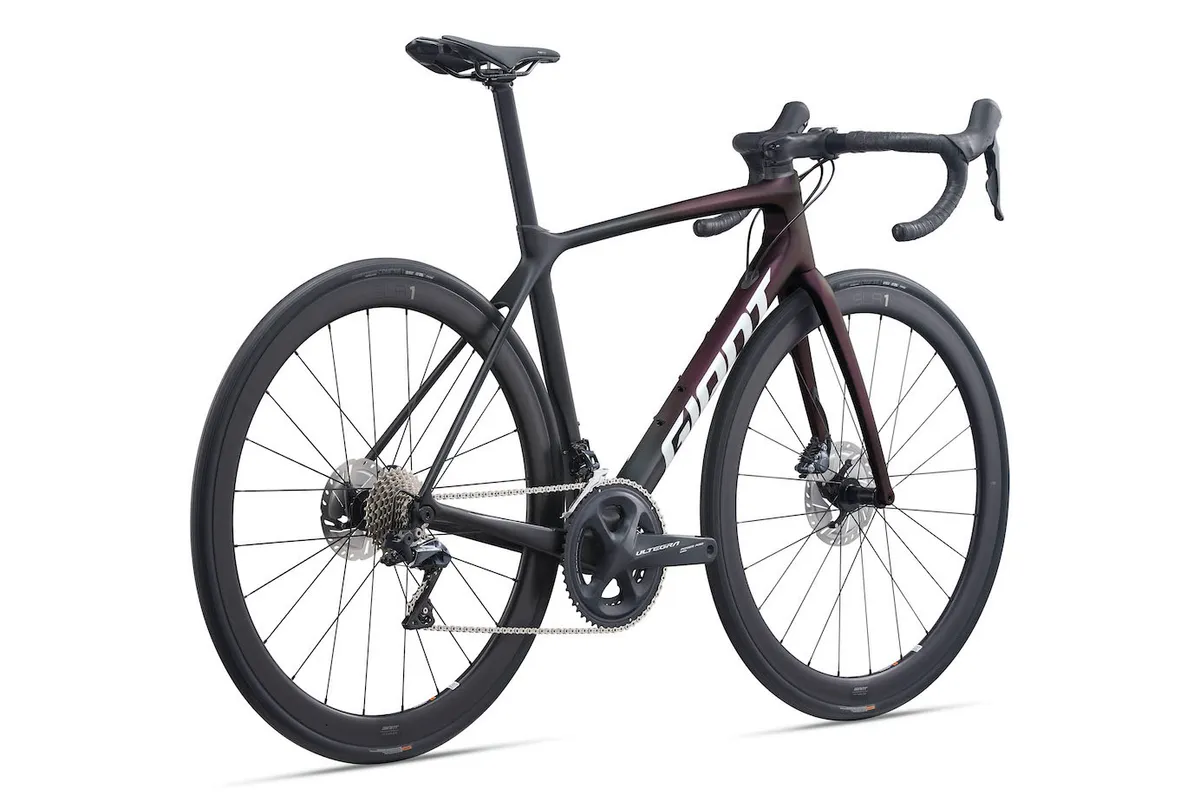
- Frame: Advanced-Grade Composite, disc
- Fork: Advanced-Grade Composite, full-composite OverDrive 2 steerer, disc
- Bar: New Giant Contact SL
- Stem: New Giant Contact SL
- Seatpost: New Giant Variant, composite
- Saddle: New Giant Fleet SL
- Gears: Shimano Ultegra 52/36, 11-30 with Giant PowerPro power meter
- Brakes: Shimano Ultegra hydraulic, 160mm/140mm rotors
- Wheels: New Giant SLR-1 42 Carbon Disc WheelSystem
- Tyres: New Giant Gavia Course 1, tubeless, 700 x 25mm, folding
- Extras: Tubeless sealant, out-front mount (Garmin, Wahoo, Giant compatible)
- Price: £TBC / $TBC / AU$TBC /€TBC
TCR Advanced Pro 2 Disc
- Frame: Advanced-Grade Composite, disc
- Fork: Advanced-Grade Composite, full-composite OverDrive 2 steerer, disc
- Bar: New Giant Contact SL
- Stem: New Giant Contact SL
- Seatpost: New Giant Variant, composite
- Saddle: New Giant Fleet SL
- Gears: Shimano 105 52/36, 11-30
- Brakes: Shimano 105 hydraulic, 160mm/140mm rotors
- Wheels: New Giant SLR-1 42 Carbon Disc WheelSystem
- Tyres: New Giant Gavia Course 1, tubeless, 700 x 25mm, folding
- Extras: New Computer mount (Garmin/Wahoo/Giant compatibility), Giant RideSense speed/cadence transmitter ANT+/BLE, tubeless sealant
- Price: £TBC / $TBC / AU$TBC / €TBC
TCR Advanced 1 Disc
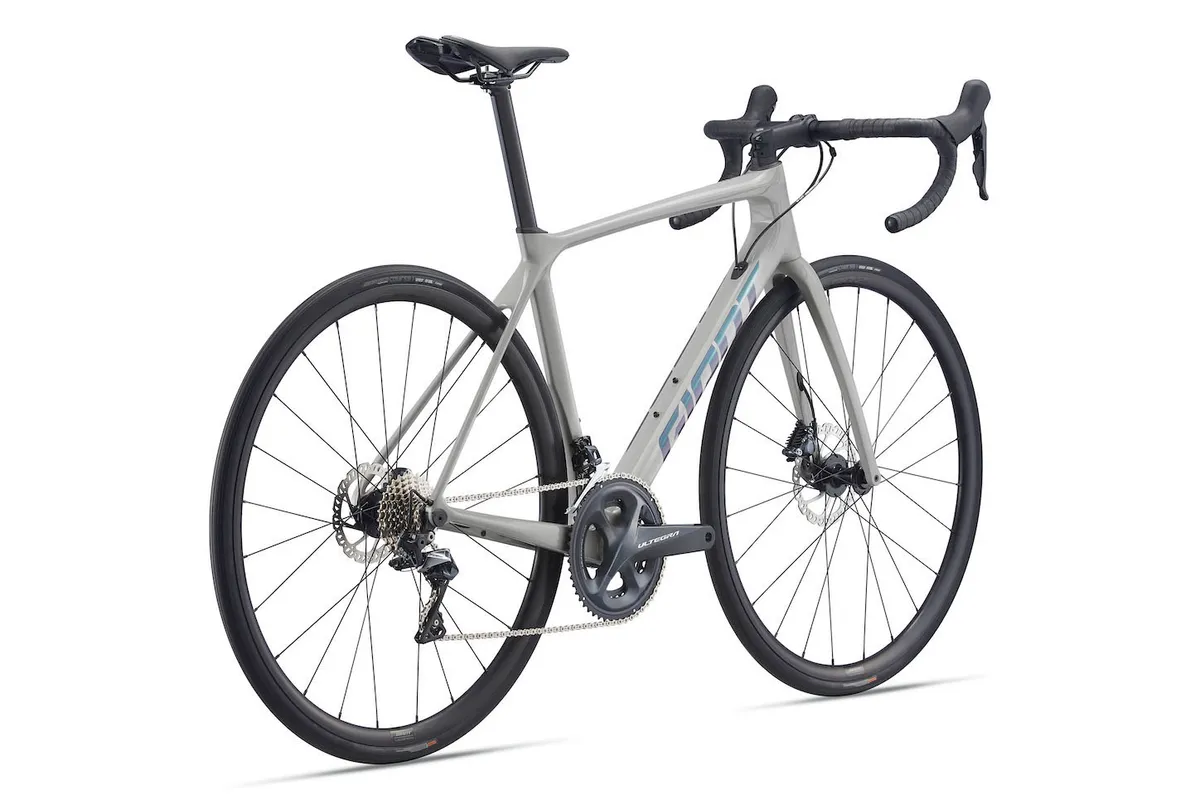
- Frame: Advanced-Grade Composite, disc
- Fork: Advanced-Grade Composite, composite OverDrive steerer, disc
- Bar: Giant Contact
- Stem: Giant Contact
- Seatpost: New Giant Variant, composite
- Saddle: New Giant Approach
- Gears: Shimano Ultegra 52/36 11-30 (with Shimano RS510 chainset and 105 cassette)
- Brakes: Shimano Ultegra hydraulic, 160mm/140mm rotors
- Wheels: New Giant PR-2 Disc wheelset
- Tyres: New Giant Gavia Course 1, tubeless, 700 x 25mm, folding
- Extras: Tubeless sealant
- Price: £TBC / $TBC / AU$TBC / €TBC
TCR Advanced 2 Disc
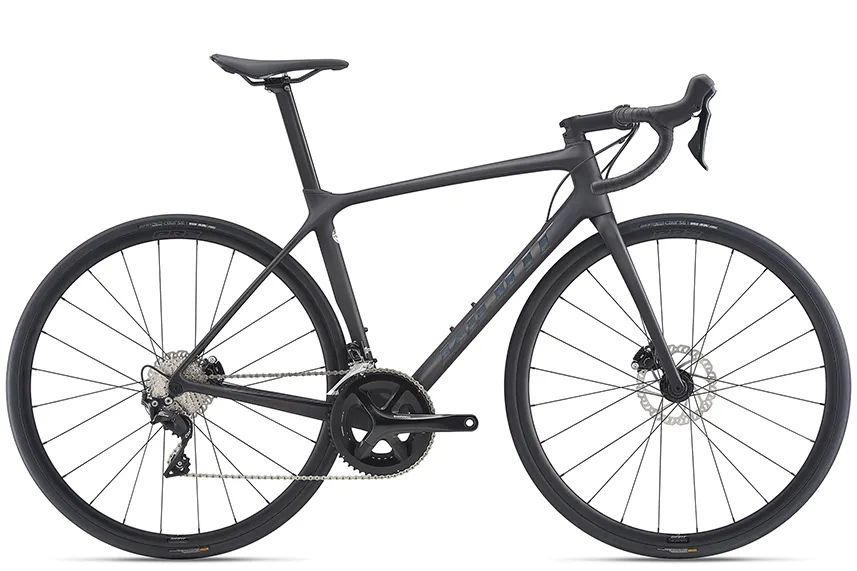
- Frame: Advanced-Grade Composite, disc
- Fork: Advanced-Grade Composite, composite OverDrive steerer, disc
- Bar: Giant Contact
- Stem: Giant Contact
- Seatpost: New Giant Variant, composite
- Saddle: New Giant Approach
- Gears: Shimano 105 52/36, 11-30 (with Shimano RS-510 chainset)
- Brakes: Shimano 105 hydraulic, 160mm/140mm rotors
- Wheels: New Giant PR-2 Disc wheelset
- Tyres: New Giant Gavia Course 1, tubeless, 700 x 25mm, folding
- Extras: Tubeless sealant
- Price: £TBC / $TBC / AU$TBC / €TBC
TCR Advanced 3 Disc
- Frame: Advanced-Grade Composite, disc
- Fork: Advanced-Grade Composite, composite OverDrive steerer, disc
- Bar: Giant Contact
- Stem: Giant Contact
- Seatpost: New Giant Variant, composite
- Saddle: New Giant Approach
- Gears: Shimano Tiagra 50/34, 11-32
- Brakes: Shimano Tiagra hydraulic, 160mm/140mm rotors
- Wheels: New Giant PR-2 Disc wheelset
- Tyres: New Giant Gavia Course 1, tubeless, 700 x 25mm, folding
- Extras: Tubeless sealant
- Price: £TBC / $TBC / AU$TBC / €TBC
TCR Advanced Pro 1
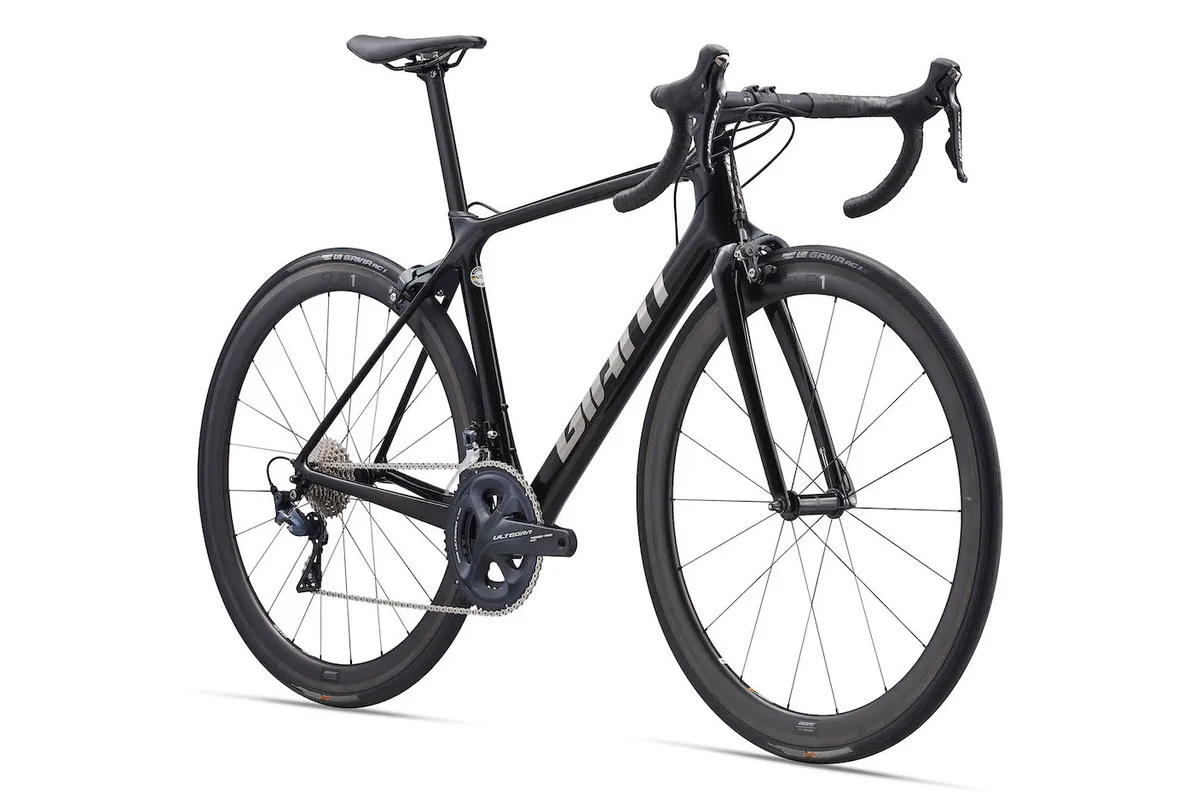
- Frame: Advanced-Grade Composite
- Fork: Advanced-Grade Composite, full-composite OverDrive 2 steerer
- Bar: Giant Contact SL
- Stem: Giant Contact SL
- Seatpost: New Giant Variant, composite
- Saddle: New Giant Fleet SL
- Gears: Shimano Ultegra 52/36, 11-30 with Giant PowerPro power meter
- Brakes: Shimano Ultegra
- Wheels: New Giant SLR-1 42 Carbon WheelSystem
- Tyres: New Computer mount (Garmin/Wahoo/Giant compatibility), tubeless sealant
- Price: £TBC / $TBC / AU$TBC / €TBC
TCR Advanced 2
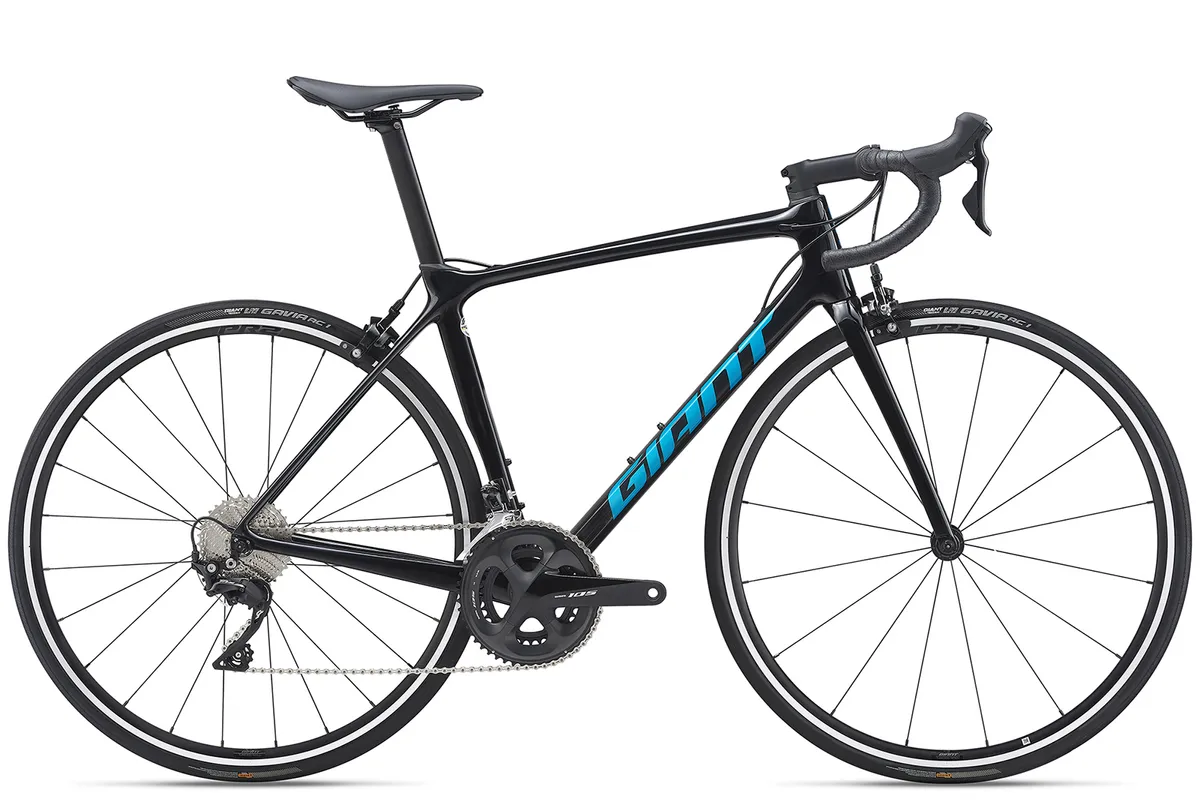
- Frame: Advanced-Grade Composite
- Fork: Advanced-Grade Composite, full-composite OverDrive 2 steerer
- Bar: Giant Contact
- Stem: Giant Contact
- Saddle: New Giant Approach
- Gears: Shimano 105 52/36, 11-30
- Brakes: Shimano 105
- Wheels: New Giant PR-2 wheelset
- Tyres: Giant Gavia AC 1, tubeless, 700 x 25mm, folding
- Extras: Tubeless sealant
- Price: £TBC / $TBC / AU$TBC / €TBC
TCR Advanced SL Disc frameset
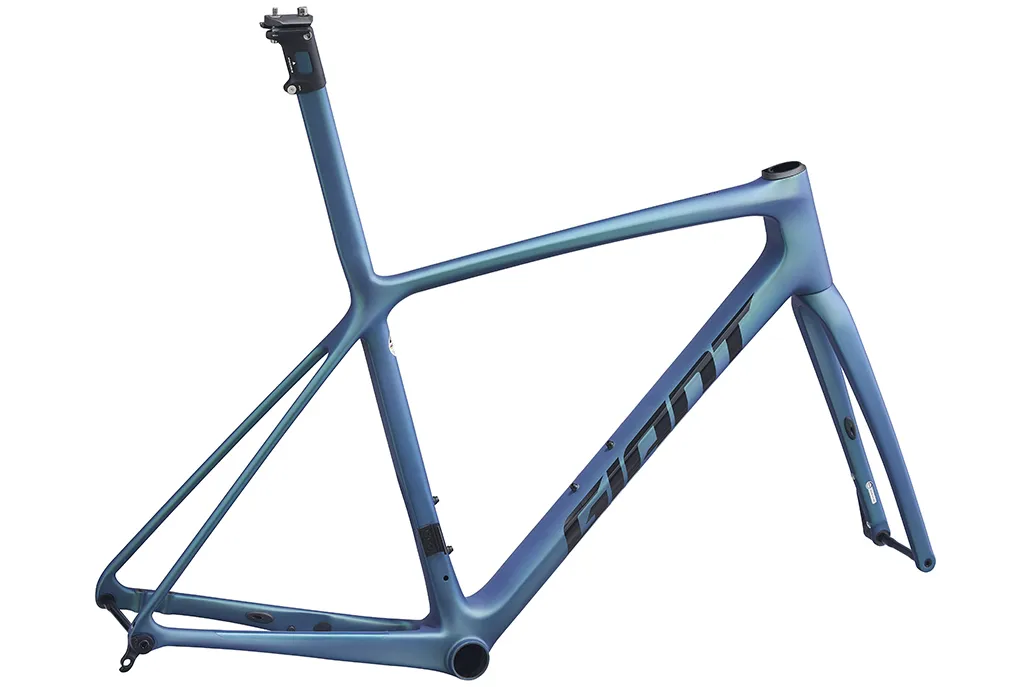
This frame is designed for electronic shifting only.
- Sizes: S, M, ML, L, XL
- Frame: Advanced SL-Grade Composite, integrated seatpost, disc
- Fork: Advanced SL-Grade Composite, full-composite OverDrive 2 steerer, disc
- Seatpost: Integrated design, two clamps 25mm/45mm
- Extras: 12mm thru-axles, Giant RideSense speed/cadence transmitter ANT+/BLE
- Price: £TBC / $TBC / AU$TBC / €TBC
TCR Advanced Pro Disc frameset
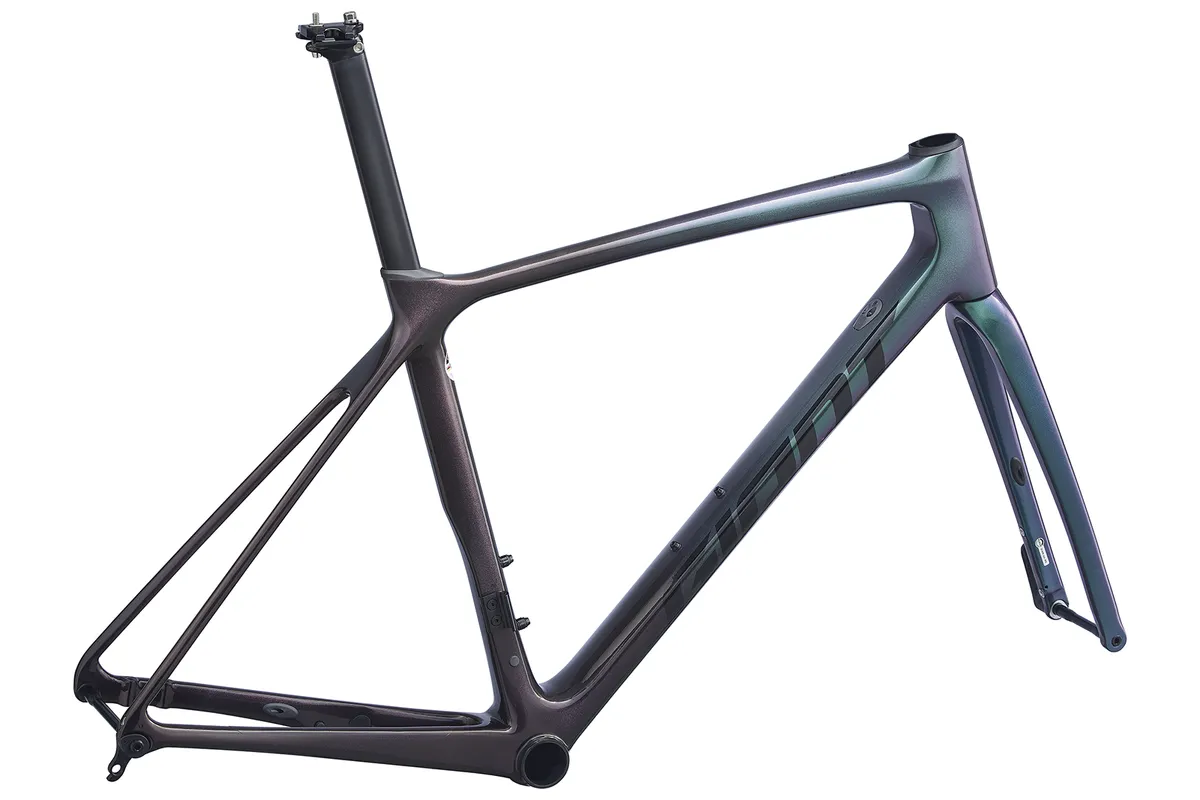
- Sizes: XS, S, M, ML, L, XL
- Frame: Advanced-Grade Composite, disc
- Fork: Advanced-Grade Composite, full-composite OverDrive 2 steerer, disc
- Seatpost: New Giant Variant, composite
- Extras: 12mm thru-axles, Giant RideSense speed/cadence transmitter ANT+/BLE
- Price: £TBC / $TBC / AU$TBC / €TBC
TCR Advanced SL frameset
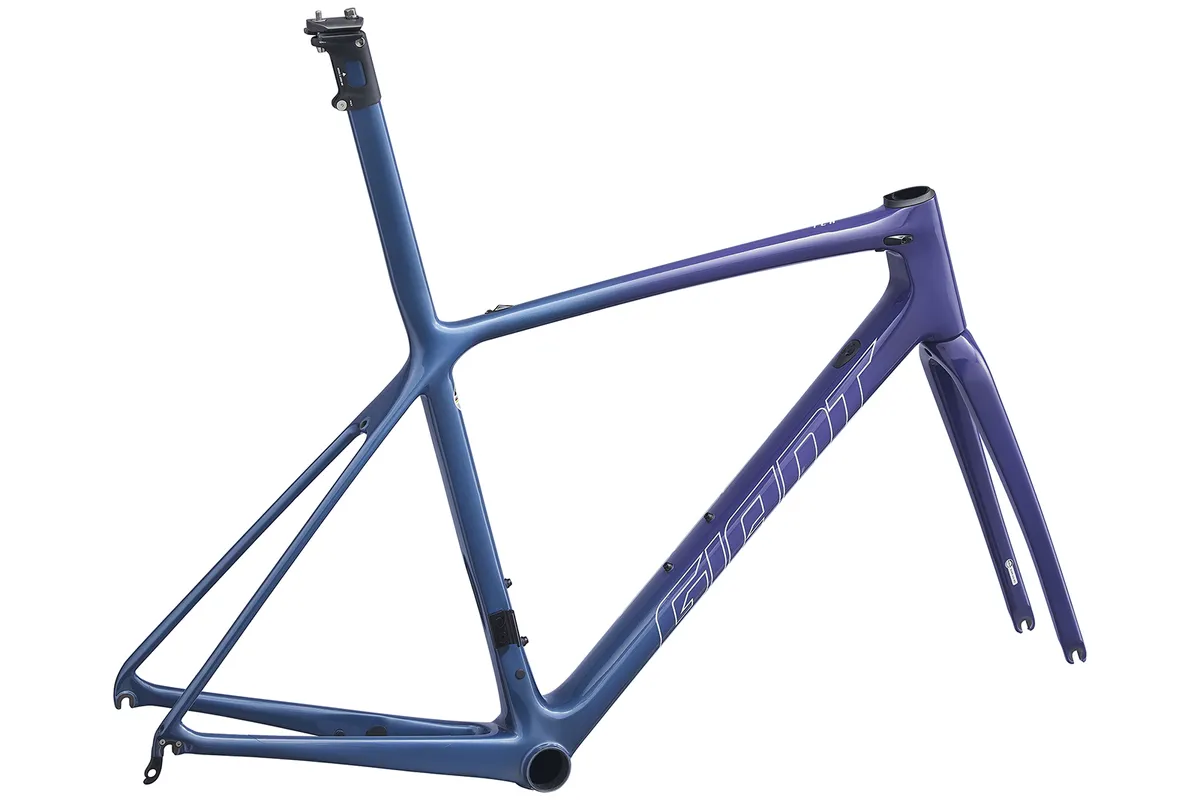
- Sizes: S, M, ML, L, XL
- Frame: Advanced SL-Grade Composite, integrated seatpost
- Fork: Advanced SL-Grade Composite, full-composite OverDrive 2 steerer
- Seatpost: Integrated design, two clamps 25mm/45mm
- Extras: Giant RideSense speed/cadence transmitter ANT+/BLE
- Price: £TBC / $TBC / AU$TBC / €TBC
